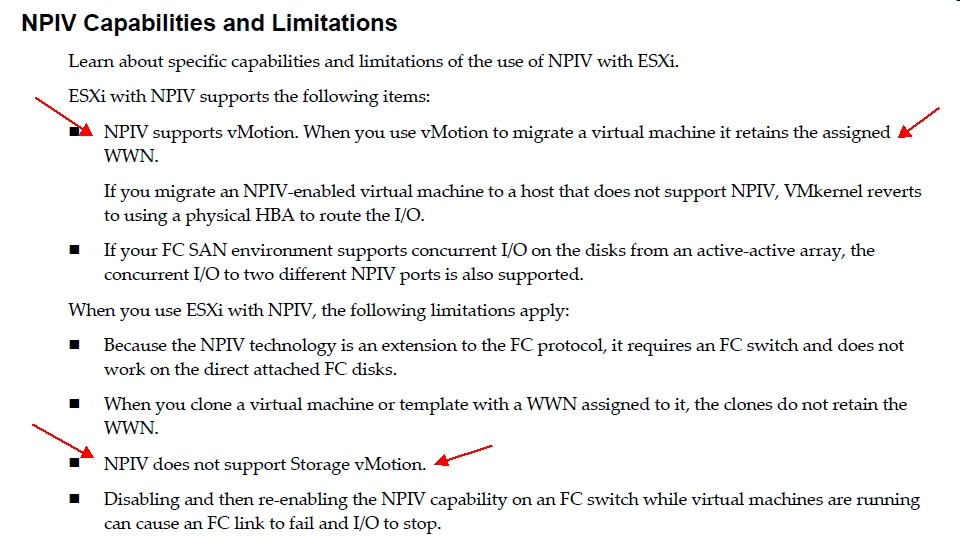An administrator finds that vMotion and Storage VMotion operations do not succeed on a virtual machine. The virtual machine has been configured with N_Port ID Virtualization. The virtual machine has two data RDMs, one using a RAID 5 LUN on using a RAID0+1 LUN. The mapping file for RAID 5 LUN was created on the same datastore as the virtual machine, and the mapping file for the RAID0+1 LUN was placed in a datastore used for production data virtual disks.
Which two statements are true about this configuration? (Choose two)

A.
vMotion cannot be used unless both mapping files are placed on the same datastore.
B.
Storage vMotion cannot be used unless both mapping files are placed on the same datastore.
C.
Storage vMotion cannot be used with NPIV.
D.
vMotion cannot be used with NPIV
Explanation:
Page 40 from vsphere-esxi-vcenter-server-50-storage-guide.pdf



B & C
C is definitivly and B was an issue during ESX 3.5 time when configuring it “graphical” – you would have a naming conflict when creating the deltas. Nowadays the delta get some hashing in his name and would not conflict.
0
0
Admin, can we edit the A. answer on this one?
it reads…
A.
vMotion cannot be used unless boot mapping files are placed on the same datastore.
it SHOULD read….
A.
vMotion cannot be used unless both mapping files are placed on the same datastore.
Here is why…
The VMs have 2 RDMs assigned to them, when you add an rdm to a vm, it creates the mapping file and a raw file in the folder for that VM. The problem indicates one RDM mapping file is kept on shared storage, the other on a datastore used by production, and not the storage used by Vms.
The answer A is correct, ONLY if the word boot is changed to both, There is no boot mapping file in the Vms folder for tha Virtual Machine with an rdm attached.
thanks..
0
0
Thanks Scott. I have fixed it.
0
0
A little more info for the techies…
the 2 files created when adding a single RDM into a VM….
The –flat.vmdk file
This is the default large virtual disk data file that is created when you add a virtual hard drive to your VM that is not an RDM. When using thick disks, this file will be approximately the same size as what you specify when you create your virtual hard drive. One of these files is created for each virtual hard drive that a VM has configured, as shown in the examples below.
The -rdm.vmdk file
This is the mapping file for the RDM that manages mapping data for the RDM device. The mapping file is presented to the ESX host as an ordinary disk file, available for the usual file system operations. However, to the virtual machine the storage virtualization layer presents the mapped device as a virtual SCSI device. The metadata in the mapping file includes the location of the mapped device (name resolution) and the locking state of the mapped device. If you do a directory listing you will see that these files will appear to take up the same amount of disk space on the VMFS volume as the actual size of the LUN that it is mapped to, but in reality they just appear that way and their size is very small. One of these files is created for each RDM that is created on a VM
0
0
I was a little quick there so ignore the first file type as that doesn’t apply. There is only the mapping file stored for rdms…
0
0